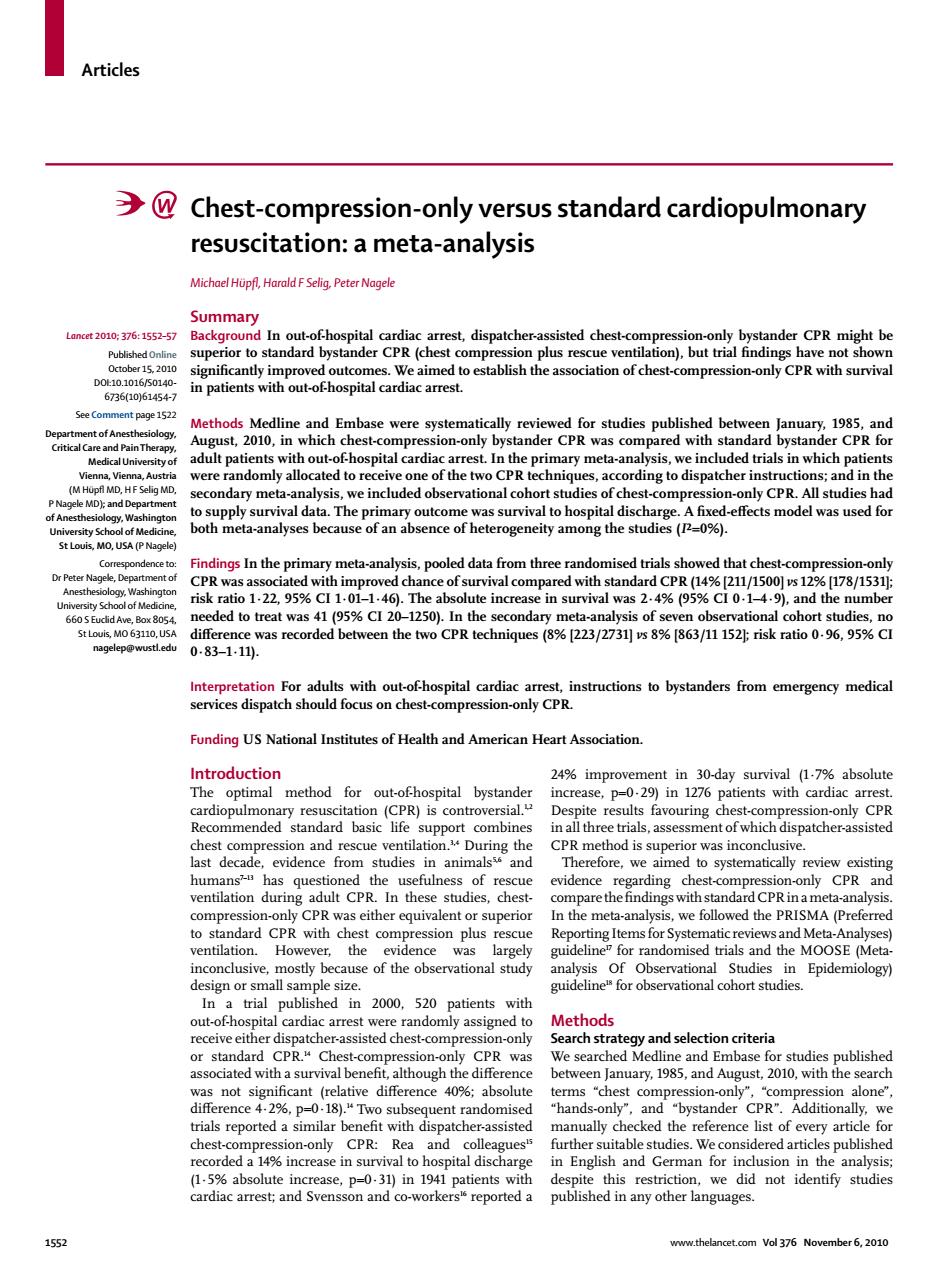正在加载图片...

Articles Chest-compression-only versus standard cardiopulmonary resuscitation:a meta-analysis Michae Hupf.HaraldFSig Peter Nagcle Summary 2010,376155257 r1520 69606454 in patients with ou ebi the oof cheompres cardiac arres adult patients with out-o were ra nly alloc d to re ording to dispatcher ins in th All studi analyses bec 12%78 risk ratio 195%CI1-01-16).The absolute incre 0-83-11. Interpretation For adults with out-ofhospital cardiac arrest,instructions to bystanders from emergency medical services dispatch should focus on chest-compression-only CPR. Funding US National Institutes of Health and American Heart Association. Introduction 24%improvement in 30-day survival (1.7%absolute The optimal method for bystande increase,p 029in1276 patients with cardiac arres que the usefulness of rescu ding cl ign or small s oooepl2at m0 wit arrest wer Methods r standard CPR.Chest-c chest CPR wa between January.1985.and August,2010.with the search hands-only che Is reported a simila anually ch CPR: of every ysis and nd新 published in any other languagcs. Vol 376 Novembet 6.2010 Articles 1552 www.thelancet.com Vol 376 November 6, 2010 Lancet 2010; 376: 1552–57 Published Online October 15, 2010 DOI:10.1016/S0140- 6736(10)61454-7 See Comment page 1522 Department of Anesthesiology, Critical Care and Pain Therapy, Medical University of Vienna, Vienna, Austria (M Hüpfl MD, H F Selig MD, P Nagele MD); and Department of Anesthesiology, Washington University School of Medicine, St Louis, MO, USA (P Nagele) Correspondence to: Dr Peter Nagele, Department of Anesthesiology, Washington University School of Medicine, 660 S Euclid Ave, Box 8054, St Louis, MO 63110, USA nagelep@wustl.edu Chest-compression-only versus standard cardiopulmonary resuscitation: a meta-analysis Michael Hüpfl , Harald F Selig, Peter Nagele Summary Background In out-of-hospital cardiac arrest, dispatcher-assisted chest-compression-only bystander CPR might be superior to standard bystander CPR (chest compression plus rescue ventilation), but trial fi ndings have not shown signifi cantly improved outcomes. We aimed to establish the association of chest-compression-only CPR with survival in patients with out-of-hospital cardiac arrest. Methods Medline and Embase were systematically reviewed for studies published between January, 1985, and August, 2010, in which chest-compression-only bystander CPR was compared with standard bystander CPR for adult patients with out-of-hospital cardiac arrest. In the primary meta-analysis, we included trials in which patients were randomly allocated to receive one of the two CPR techniques, according to dispatcher instructions; and in the secondary meta-analysis, we included observational cohort studies of chest-compression-only CPR. All studies had to supply survival data. The primary outcome was survival to hospital discharge. A fi xed-eff ects model was used for both meta-analyses because of an absence of heterogeneity among the studies (I²=0%). Findings In the primary meta-analysis, pooled data from three randomised trials showed that chest-compression-only CPR was associated with improved chance of survival compared with standard CPR (14% [211/1500] vs 12% [178/1531]; risk ratio 1·22, 95% CI 1·01–1·46). The absolute increase in survival was 2·4% (95% CI 0·1–4·9), and the number needed to treat was 41 (95% CI 20–1250). In the secondary meta-analysis of seven observational cohort studies, no difference was recorded between the two CPR techniques (8% [223/2731] vs 8% [863/11 152]; risk ratio 0·96, 95% CI 0·83–1·11). Interpretation For adults with out-of-hospital cardiac arrest, instructions to bystanders from emergency medical services dispatch should focus on chest-compression-only CPR. Funding US National Institutes of Health and American Heart Association. Introduction The optimal method for out-of-hospital bystander cardiopulmonary resuscitation (CPR) is controversial.1,2 Recommended standard basic life support combines chest compression and rescue ventilation.3,4 During the last decade, evidence from studies in animals5,6 and humans7–13 has questioned the usefulness of rescue ventilation during adult CPR. In these studies, chestcompression-only CPR was either equivalent or superior to standard CPR with chest compression plus rescue ventilation. However, the evidence was largely inconclusive, mostly because of the observational study design or small sample size. In a trial published in 2000, 520 patients with out-of-hospital cardiac arrest were randomly assigned to receive either dispatcher-assisted chest-compression-only or standard CPR.14 Chest-compression-only CPR was associated with a survival benefi t, although the diff erence was not signifi cant (relative diff erence 40%; absolute diff erence 4·2%, p=0·18).14 Two subsequent randomised trials reported a similar benefi t with dispatcher-assisted chest-compression-only CPR: Rea and colleagues15 recorded a 14% increase in survival to hospital discharge (1·5% absolute increase, p=0·31) in 1941 patients with cardiac arrest; and Svensson and co-workers16 reported a 24% improvement in 30-day survival (1·7% absolute increase, p=0·29) in 1276 patients with cardiac arrest. Despite results favouring chest-compression-only CPR in all three trials, assessment of which dispatcher-assisted CPR method is superior was inconclusive. Therefore, we aimed to systematically review existing evidence regarding chest-compression-only CPR and compare the fi ndings with standard CPR in a meta-analysis. In the meta-analysis, we followed the PRISMA (Preferred Reporting Items for Systematic reviews and Meta-Analyses) guideline17 for randomised trials and the MOOSE (Metaanalysis Of Observational Studies in Epidemiology) guideline18 for observational cohort studies. Methods Search strategy and selection criteria We searched Medline and Embase for studies published between January, 1985, and August, 2010, with the search terms “chest compression-only”, “compression alone”, “hands-only”, and “bystander CPR”. Additionally, we manually checked the reference list of every article for further suitable studies. We considered articles published in English and German for inclusion in the analysis; despite this restriction, we did not identify studies published in any other languages